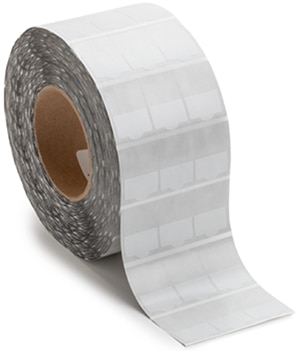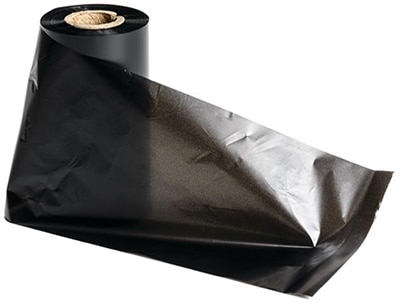使用黏貼方便的纜線標籤解決維護問題
資料提供者:DigiKey 北美編輯群
2025-09-09
在複雜的佈線環境中,如資料中心、電信機櫃和工業控制面板等,清晰的標籤是識別和整理線材的必備工具。然而,手動貼標容易出錯且耗時,因此會導致人力成本增加、停機時間延長,並讓操作人員受挫。標籤也會隨著時間劣化,特別是在頻繁取用的環境中,膠黏失效和墨水模糊可能會導致標籤遺失或無法辨識。
本文將探討技術人員在纜線貼標及執行例行維護時常見的挑戰。接著會介紹來自 HellermannTyton 的自黏標籤,並展示這些解決方案的創新設計如何促成快速貼附且持久耐用的標籤。也會探討安裝前用來列印這些標籤的工具和軟體。
在經常維修的環境中進行纜線貼標
在擁擠的連接環境中,簡易的纜線辨識是快速維修與故障排除的重要關鍵。纜線兩端若有清晰的標籤,就無需猜測纜線的身份,也就無需沿著一整條纜線,或穿越機箱、線束或牆壁開口來進行追溯。這些標籤必須牢牢固定才能發揮效用。只要簡化纜線識別,技術人員在系統操作上也會更加安全。舉例而言:
- 清晰的標籤有助於正確連接,並可避免設備受損或人員受傷。
- 兩端都貼標就可在定位與追蹤纜線時,減少人為處理纜線的需求;不必要的處理可能會導致損壞,進而縮短纜線的使用壽命。
- 標籤可傳達纜線的功用。以傳輸電力的纜線為例,若有需要進行處理,就可以採取適當的預防措施。
若要在密集佈線的情況下手動貼標,自黏式包覆標籤是經濟可靠的選擇。貼紙型設計幾乎不會增加纜線的厚度,並可透過內建的貼膜保護識別碼。此貼模通常具備抗水、抗污及耐磨損的特性,有助於確保電纜上的代碼在電纜的整個使用壽命期間保持清晰可讀。此雙步驟包覆流程亦可促進穩固且持久的附著,無需額外的緊固件或黏貼工具。
纜線人工貼標的挑戰
儘管自黏式包覆標籤具有諸多優點,但其背膠在黏貼過程中可能會造成困難。人工貼標的整體流程可能會因為指甲剪太短這種微不足道的事情而明顯變慢。標籤在背襯紙上若密集排列,可能會難以剝離,導致維修作業時的時間浪費。
接切標籤會加劇此問題,且礙於標籤材料本身的彎曲半徑,對較小的線徑來說也會造成困難。線徑越小,人工黏貼就越困難。進大量的纜線貼標時,這些低效率會累積,進而增加人力成本及錯誤發生的可能性。
在大規模貼標下,識別碼的標記也會帶來挑戰。雖然已經有可攜式標籤機,但列印速度可能較慢,尤其是必須逐一輸入識別碼時。
手寫也是一種選擇,但也有其特定問題。書寫疲勞與簽字筆使用不當,都可能導致字跡難以辨識,或墨水隨時間暈染或褪色。這些問題最終可能導致貼標作業白做工。
創新的自黏標籤作法
藉由自黏式包覆標籤標準設計的改良,HellermannTyton 可解決人工貼標作業的相關操作問題。其 TabTags 自黏標籤 (圖 1) 結合了符合人體工學的接片,既是包覆的固定點,也是自行分離機制,以方便從背襯紙上輕鬆取下。此外,標籤之間巧妙分隔,因此可單獨取出個別標籤,而不會影響其他標籤。
 圖 1:TabTags 使用四步驟流程快速安裝。(圖片來源:Kenton Williston,以 HellermannTyton 的原始資料為基礎)
圖 1:TabTags 使用四步驟流程快速安裝。(圖片來源:Kenton Williston,以 HellermannTyton 的原始資料為基礎)
參考圖 1,步驟 1 顯示如何彎折襯紙以露出接片,以便標籤快速分離。步驟 2,將接片固定在纜線上,即使是小直徑電線也能順利包覆,可避免初次黏貼時常發生的滑動現象。從步驟 3 開始,貼標作業就像標準的自黏包覆標籤一樣:將印刷部分繞在電線上,接著用貼膜部分保護印刷識別碼。
TabTags 系統可消除從背襯紙上取出標籤以及貼至纜線時常遇到的阻礙,因此每小時貼標數量可提升約 12%,並可達到可靠持久的效果。此生產量的提升可大幅節省時間與所需的人力成本。
多種標籤尺寸可覆蓋簡易到複雜的配置
TabTags 系列包含多種品項,可配合不同類型的纜線及識別碼要求。596-12201 (圖 2) 是最大型的款式,尺寸為 25.4 × 39.6 mm。加寬尺寸可支援更長的識別碼,以便在纜線需要更詳細或更容易判讀身份的情況使用。此標籤長度適用於外徑介於 2.5 至 7.6 mm 之間的較粗纜線,包括 RG6 同軸、HDMI、CAN 匯流排及標準乙太網路纜線。
 圖 2:大型 596-12201 TabTags 標籤每一列有三片,每一卷有 5000 件。(圖片來源:HellermannTyton)
圖 2:大型 596-12201 TabTags 標籤每一列有三片,每一卷有 5000 件。(圖片來源:HellermannTyton)
相反地,596-12203 (圖 3) 是最小型的 TabTags 款式,尺寸為 12.7 mm × 20.8 mm。較窄的寬度適用於較簡易系統中的簡潔識別碼,或是標籤寬度有限制的情況。這些標籤專為小線徑纜線而設計,例如多芯推入式 (MPO) 光纖、細型及超細型乙太網路,以及外徑最高可達 4.3 mm 的 USB 纜線。
 圖 3:596-12203 TabTags 標籤適用於較細的線徑,每一列有六片,每一卷共有 10,000 件。(圖片來源:HellermannTyton)
圖 3:596-12203 TabTags 標籤適用於較細的線徑,每一列有六片,每一卷共有 10,000 件。(圖片來源:HellermannTyton)
HellermannTyton 也提供額外的 TabTags 選項,可在粗電線上支援短碼,以及較細電線上支援長碼。此系列的所有產品皆採用白色與透明 100B 乙烯基材料製造,並使用丙烯酸黏膠。可抗紫外線 (UV),且工作溫度範圍介於 -40 至 +96°C,可在嚴苛環境中提供穩健效能。
簡化標籤列印作業並提供彩色選項
使用 TabTags 系統時,有個關鍵步驟就是確保安裝前纜線的識別碼清晰列印。TT230SM (556-00230) 列印機 (圖 4) 就專為此任務而設計。其採用輕巧、緊湊的外型設計,能跟著技術人員的標準配備一同攜帶。
 圖 4:TT230SM 是緊湊的桌上型列印解決方案,能快速製作多張標籤且設置時間極短。(圖片來源:HellermannTyton)
圖 4:TT230SM 是緊湊的桌上型列印解決方案,能快速製作多張標籤且設置時間極短。(圖片來源:HellermannTyton)
此列印機的特點包括:
- 具有 300 dpi 列印頭,可達到高解析度的標籤列印效果
- 具有高精度感測器,因此標籤改變時也無需校正,可節省時間並減少錯誤
- 列印快速,可達到大量標籤的批次生產效率
- 有 LCD 使用者介面,能簡化設定、診斷與調整作業
TT230SM 能以套件型式購買 (556-00239),其中含有電源與電腦連接所需的纜線、方便操作的標籤盒、一捲黑色熱轉印色帶、TagPrint Pro 標籤設計軟體,以及耐用的硬殼手提箱。
熱轉印色帶亦可單獨購買,並提供多種顏色,包括標準黑色,如 TT822OUTSM (圖 5)。這款 15 m 的樹脂基底色帶可提供優異的列印持久性,並具有抗化學物質與抗磨損的特性,耐溫達 +82°C。內建清潔機制,可延長列印頭壽命,有助於降低 HellermannTyton 列印生態系統的維護成本。
 圖 5:TT822OUTSM 15m 熱轉印色帶提供優異的列印持久性。(圖片來源:HellermannTyton)
圖 5:TT822OUTSM 15m 熱轉印色帶提供優異的列印持久性。(圖片來源:HellermannTyton)
使用 TagPrint Pro 簡化貼標作業
TagPrint Pro 是 HellermannTyton 列印機發揮最大效益的關鍵軟體工具。相容於 Windows 作業系統,可支援多標籤自動列印,並提供視覺化預覽功能。可在針對替代纜線製作全新標籤,或針對新架設進行大量批次製作時簡化相關流程。
可在單一檔名中集結完整的系統標籤要求,讓使用者在列印時就可透過目視或零件編號,快速找到特定標籤。如此一來,就無需手動搜尋參考資料,因為 TagPrint Pro 已提供此服務。此軟體亦支援條碼、QR 碼及圖形列印 (圖 6),可配合標準文字標籤以外的應用需求。
 圖 6:TagPrint Pro 可針對需要大量標籤的大型系統提供簡化的列印環境。(圖片來源:HellermannTyton)
圖 6:TagPrint Pro 可針對需要大量標籤的大型系統提供簡化的列印環境。(圖片來源:HellermannTyton)
結論
為了促進安全操作,並減少維護常用系統時所耗費的時間與成本,擁有清晰且有效的纜線標籤相當關鍵。HellermannTyton 的 TabTags 系統能以符合人體工學的接片,改善標籤處理作業並簡化應用流程,因此能提升操作人員的效率,藉此達到上述目標。此標籤系統更結合了相關的列印硬體和軟體,可在多種應用中達到清晰、穩健且符合成本效益的纜線管理。

聲明:各作者及/或論壇參與者於本網站所發表之意見、理念和觀點,概不反映 DigiKey 的意見、理念和觀點,亦非 DigiKey 的正式原則。










